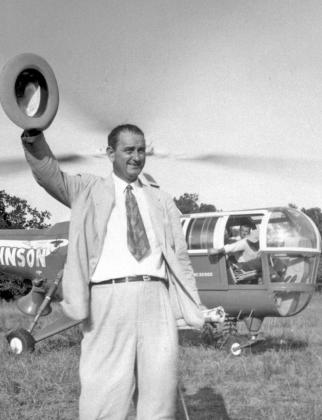He was one of the first politicians to campaign by helicopter. Johnson was behind in the polls and needed something unusual to get people’s attention and to shake as many hands as possible.
Lyndon Baines Johnson visited Dublin on June 29, 1948. His helicopter landed near the Colborn bowl and he spoke there to a small crowd. He spoke of confidence, courage and preparedness in relations with other nations. Johnson also supported soil conservation.
In the runoff election, Johnson defeated Coke Stevenson in the Democratic primary race to be the party’s candidate for the Texas Senate seat November 2 in the 1948 general election.
Lyndon Johnson’s eventual win ended up being helpful in the building of low income housing in Dublin. The January 6, 1950 Dublin Progress Headline said “ Half Million Dollar Housing Project Approved.” A telegram from Lyndon B. Johnson read: “Delighted to tell you Public Housing Administration has approved the allocation of 50 unit low rent housing to Dublin Housing Authority.”
The headline in the Dublin Progress from February 17, 1950 said “President (Truman) Approves First Loan On Dublin’s Housing Project.” This notification was sent from the offices of Congressman Omar Burleson and Senator Lyndon B. Johnson.
The telegrams were received by Pharmacist George Skeen, secretary of the Dublin Housing Project. A preliminary loan of $20,000 was approved as a first to get the project started. He continued “Other loans are expected to go through from time to time until the 50 unit housing project is completed. The project could amount to several hundred thousand dollars before completion. Plans now call for as many as 200 housing units if the need is here.”
The March 24, 1950 Dublin Progress stated that C.E. Leatherwood would be resigning from his position at the Dublin National Bank to lead the completion of the Dublin Housing Project.
The December 15, 1950 Dublin Progress said that a $349,675 bid was accepted to build a 50 unit project. Executive Director Leatherwood said that construction should begin in a few weeks.
In the December 29th issue the headline read “Housing Authority Work To Begin Monday.” The $419,000 will be for 25 duplex apartments housing 50 families. Renters will be determined by the housing authority board.
Almost a year later and after lots of work, the housing project was nearing completion. The November 30, 1951 Dublin Progress stated that 20 families were already located in the new housing. “The rent is based on income and includes all utilities. Refrigerators, wall heaters and all bathrooms complete are included in the price.”
The three streets in the housing project are Ireland St., Bryan St. and Austin St. Ireland was picked to fit the Irish name of Dublin.
Bryan was picked to honor Dr. T. F. Bryan, and Austin St. was picked honoring the capital of Texas. C. E. Leatherwood in a talk at the local Rotary Club stated that “This project is literally changing the lives of some of the families that are moving there. If you will drive out and go through the project, I believe that you will be glad that we have this here.”
In the 70 years since then, the Dublin Housing Project has provided much needed living space to help low income families.

